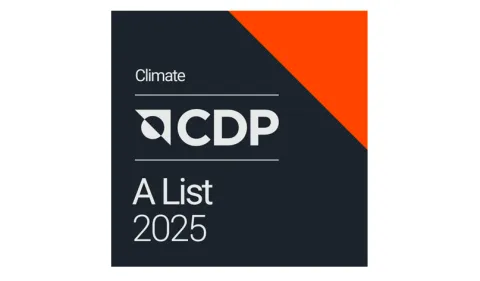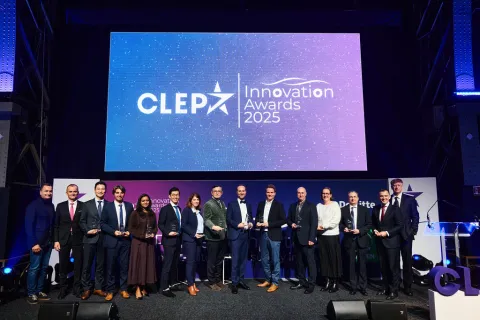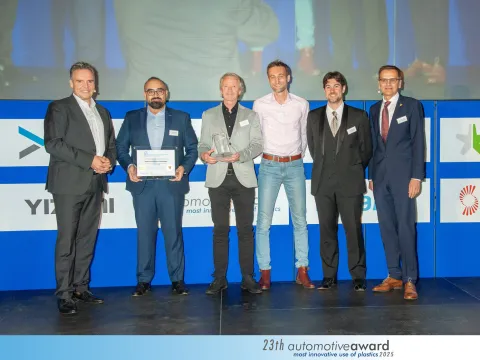
Waves of Innovation: driving environmental progress in manufacturing

FORVIA’s Blue Effect embodies the practical, measurable actions we take across all our plants to reduce our environmental impact. At the heart of our strategy is our roadmap to Net Zero by 2045. Our next milestone in our roadmap is achieving at least 80% reduction in our scopes 1 & 2 CO2 emissions – those generated directly from our operations – by 2025. This ambition comes to life at every site. Yet our environmental vision goes beyond carbon: we take a holistic approach, aiming for zero waste, zero pollution of air, water, and soil, and minimal impact on biodiversity.
The 10 Green Fundamentals
FORVIA’s commitment to reducing our footprint is built on the 10 Green Fundamentals, a set of practical standards applied across every plant. These fundamentals cover the full scope of plant operations, ensuring each site manages its direct impact in a structured, measurable way.
Energy consumption is a key focus. High-demand workstations are monitored closely, with clear procedures for shutdown during breaks and idle times. New equipment is vetted for efficiency, while every site maintains a CO2 reduction plan linked to climate targets and risk assessments.
Waste and water are managed with the same rigor. Plants track and reduce waste generation, with the Group aiming for a 35% cut in waste intensity by 2027 and an 80% recycling rate by 2030. Water networks are mapped to detect leaks, while rainwater and greywater systems reduce reliance on fresh supplies, particularly in high water stress areas.
Air emissions, soil protection, and chemical management are addressed through strict controls, from filtering process emissions to ensuring hazardous substances are stored safely. Biodiversity is considered at every site, and action plans are implemented when operations are located near Key Biodiversity Areas (KBAs).
Compliance with regulations is a baseline, and we integrate these requirements into daily operations, ensuring consistency across our global footprint. Sites also assess broader environmental impacts, with targeted actions developed where risks are highest.
All 10 Green Fundamentals are applied to our daily operations across all FORVIA sites and are tracked through robust data systems, with employees trained to understand how their actions contribute.
Building Sustainable Sites from the Ground Up
The Green Factory White Book defines how FORVIA designs and builds new sites to reduce our environmental footprint. It was created in response to the construction sector's large share of global CO2 emissions, approximately 10 gigatons each year.
When selecting sites, we avoid greenfield, agricultural areas and ecological hotspots, favoring brownfield with low biodiversity risk and convenient employee access. Our buildings are then designed to perform efficiently in local climates today, while accounting for expected conditions in 2030. We prioritize natural ventilation, optimized insulation, and strategic shading. Materials come from biological sources, recycled streams, or reused sources whenever possible.
Energy efficiency is achieved through solar panels, heat recovery systems, and smart building management. In 2024, 57% of the electricity used in our plants came from renewable sources, and we successfully reduced the energy intensity of our sites by 30% (measured in MWh per million euros in revenue) compared to 2019. Water conservation happens through rainwater collection and reduced consumption systems. These principles are already in place at some of our sites, such as in our BREEAM Excellent certified Allenjoie, France, plant which features 5,000 square meters of solar panels and biomass boilers.
Tackling Waste, Water, and Plastics
We've set clear targets to reduce waste intensity by 35% by 2027 (compared to 2019) and achieve an 80% recycling rate by 2030. Our Environmental Reporting Tool (ERT) tracks waste monthly, helping sites identify issues early and take corrective action when targets are off track.
All FORVIA plants focus on reducing waste at the source, improving sorting processes, reusing production scraps and packaging, and working with specialized recycling partners. In 2024, our waste intensity was 9 tons per € million in sales. For water conservation, we aim to reduce consumption by 10% by 2025 and 30% by 2030. In 2024, we reduced water intensity by 35% compared to 2019, putting us ahead of our 2025 and 2030 targets Every site should map water systems, installs meters, fixes leaks promptly, and reuses water where possible.
Beyond internal initiatives, FORVIA also engages in external partnerships to promote sustainability. Through our collaboration with Plastic Odyssey—a global initiative dedicated to reducing ocean plastic pollution—we have implemented filters and procedures in our Interiors plants to prevent plastic granules from entering rainwater systems.
Protecting Air, Soil, and Biodiversity
Specific industrial processes come with inherent environmental risks. Activities like painting, welding, and refrigeration generate emissions that can affect local air quality if not properly managed. FORVIA addresses this through efficient equipment, substituting high-emission solvents, and strict maintenance routines. Fume extraction systems and filters are installed on production lines to capture volatile compounds and particulates before they can be released into the environment. Refrigerant gases, used in cooling systems, are tracked closely, with older, high-impact substances phased out in compliance with evolving regulations.
Soil and groundwater are vulnerable to contamination from leaks or accidental spills, particularly where hazardous substances are stored or handled. To prevent this, FORVIA sites have secondary containment systems and impermeable flooring in high-risk areas such as storage zones and chemical loading bays. Procedures for managing these materials are designed to minimize the chance of environmental exposure.
FORVIA assesses the surroundings of each site using the Integrated Biodiversity Assessment Tool (IBAT) to identify potential risks to local ecosystems. These assessments inform action plans to protect habitats and support biodiversity around FORVIA’s sites.
Measuring Progress and Adapting for the Future
We track our environmental performance using verified data. Our Environmental Reporting Tool provides monthly figures on energy, water, waste, and emissions for all operations, allowing sites to monitor their progress and correct course when needed. Oversight of these efforts is embedded in the FORVIA Excellence System, our internal framework for best-in-class industrial performance, which includes environmental performance as a core audit criterion alongside safety, quality, and efficiency.
We are also looking at climate change adaptation measures for our plants, drawing on the expertise of partners such as AXA Climate to assess the exposure of our industrial footprint, Carbone4 to evaluate the resilience of our industrial processes, and Swiss Re on current and future climate risk data. These assessments guide design improvements, infrastructure upgrades, and risk management strategies to safeguard operations and employee well-being.
A Shared Effort with Collective Impact
Through coordinated actions across all sites, FORVIA continues to progress in reducing its environmental footprint in measurable ways. Initiatives to lower energy use, manage waste, conserve water, and protect biodiversity are implemented systematically, with contributions from teams across functions and regions. This collective effort reflects the core of our continuously growing Blue Effect.




